




With the holiday season just around the corner, Wild Goose Chase came to mind as the perfect former business to feature this month. They not only had the most amazing holiday decorations, but also perfect gifts for everyone on your list!
Wild Good Chase carried great home décor, furniture, lamps, antiques and unique items. They also carried women’s clothing, jewelry, accessories, and so much more!
There are hundreds of memories posted by former Wild Goose Chase customers on the Vanished Kalamazoo Facebook site that best describe the Wild Goose Chase shopping experience, including: “One of my favorite stores in Kalamazoo!” “My mom worked there for years!” “I found many wonderful things to decorate my home there!” “The owner, Patty, had such an artistic flair.” “They had the best Christmas ornaments!” “Patty had the best eclectic mix of house decor and personal items.” “It was such a fun store to roam around in.” “I still have decoration items I bought there.” “Found some wonderful treasures there.” “Loved browsing in the store.” “A fun place to shop. So many pretty things.” “Such a great store with fun things in all different price ranges.” “One of my favorites. Spent a lot of
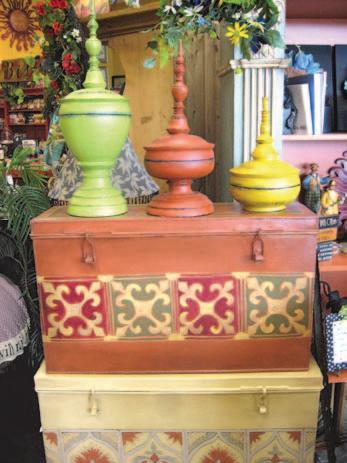


money in that store.” “The store was so much fun!” “I went there 3-4 times a month.” “Oh man, many Beanie Babies were purchased there in the late 1990’s.
Many of their items were high quality classics that were made to last. I still have two wonderful chairs in my lower level sitting room that were purchased there well over 25 years ago. I noticed a few home décor items still adorning my home and a Brighton necklace on my jewelry rack.
Owners, Patty and Herb Mais’ business venture began by happenstance, because of Herb’s passion for antiques. At one time he had booths in 13 antique malls that Patty accessorized. Before long, antique customers asked to buy the accessories Patty added, which led to customers asking for decorating and gift giving advice.

Before long, Patty realized that the next obvious step was to open a small store. She enlisted the help of a few friends to staff the store, while she continued her important work in early childhood education. Over the years, she taught kindergarten in Plainwell, was the Director of Head Start and was instrumental in opening a daycare center at KVCC. Herb
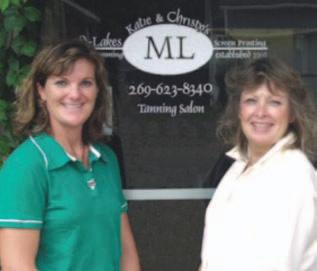
taught drafting at Delton Kellogg by day and architectural design, drafting, and graphic & industrial arts at WMU and KVCC at night.
The Mais’ opened their first store in 1978 as a hobby, located in the Westwood Plaza on W. Main Street in a small 2000 square foot space. It was tucked between two delicious landmarks, Coney Island Hot Dogs and Big Joe’s Pizza & Deli. They had four different locations over the

years in the plaza to accommodate their expansion needs. And at one time, they even had two locations in the same plaza. The second one was named Wild Goose Chase 2 (WGC2), which featured her husband’s antiques.
Their business grew rapidly and they had 5 locations at one time. The two aforementioned in the Westwood Plaza and an additional Kalamazoo location, as the anchor inside the Radisson Plaza Hotel at the Kalamazoo Center in downtown Kalamazoo. They opened in Portage inside the Carillon Center Plaza (across from Target). They also had a location in Battle Creek, for a short time.
When the former John Rollins Bookstore became available within the Westwood Plaza, the Mais’

decided to consolidated all 5 stores into the 10,000 sq. ft. large space, which had an additional 4,000 sq. ft. space in the basement for storage. Patty says she could have never done it without her staff. “They were the best staff in the world,” she said. She also feels very fortunate to have met so many wonderful friends through her business. “Friends is what life is all about,” said Patty.
The store was sold in 2008, with one stipulation, that they retain the staff. Sadly, the store closed shortly thereafter.
The Mais’ moved to Port Charlotte, Florida, where they opened a small Wild Goose Chase store. They operated the store until two years ago, when Hurricane Ian blew the roof off of the store and it flooded.
They took the hurricane disaster as a sign to retire and have taken 55 cruises in the past 2 years! Herb continues antique picking and Patty enjoys helping people decorate. Although they miss the store and the wonderful friends they met through their business, they are enjoying cruising into the next phase of their lives.
Jackie Merriam


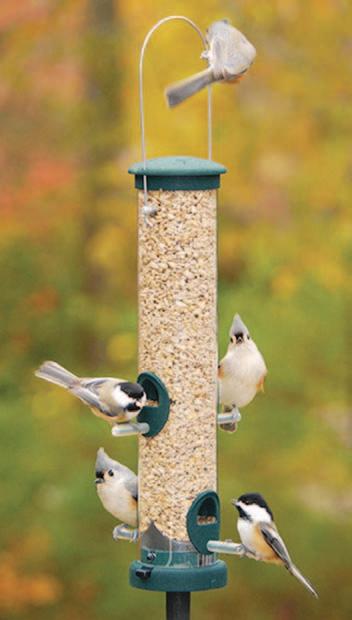
While birds will visit a variety of different feeders, the best options for winter birds are…
TRAY / PLATFORM FEEDERS
A tray or platform feeder with low sides and a wide, open base placed one to three feet above the ground will lure ground-feeding birds like juncos, towhees and mourning doves. Grouse and quail may also visit this type of feeder, and these feeders are ideal for offering food to large flocks of birds
HOPPER FEEDERS
Hung from a tree or hook or mounted on a pole, “house” style feeders with seed hoppers and perches on the side will usually entice grosbeaks, cardinals and jays, as well as sparrows and finches. These feeders help keep seed dry and can hold a larger quantity of seed so refills are not as frequent.
WEDEL’S CARRIES MADE

My family has a handful of fun sayings or phrases we use. Some are unique to us and some are not. Unbeknownst to my daughter, some

A cage-like feeder that holds a cake of rich, fatty suet is a bird magnet for woodpeckers, wrens, nuthatches, titmice, mockingbirds and jays. A standard suet cage can hold just one cake and can be hung from a pole or branch. Larger suet feeders may hold multiple cakes, and some suet feeders are even designed as logs or other shapes to hold suet plugs or balls.
TUBE
Long, cylindrical tube feeders suspended in air will bring in an array of small birds, including finches, titmice, nuthatches, siskins, redpolls and chickadees. These feeders may have either mesh-like sides where birds can easily cling, or they may have
of words and sayings she grew up hearing, aren’t universal. This was news to her and to me as well.
Something as simple as using the words “door wall” instead of sliding glass door, has been fodder for fun amongst her co-workers. “They asked her, “what’s a door wall?”
Another quirky, saying that we have been known to use is “What’s his head,” when we are looking for help to recall someone’s name. Probably not politically correct, but it’s been effective within our clan.
We have been known to say, “there’s a fly in the soup,” which
multiple perches to accommodate more birds. Sock-style feeders are also popular.
Just providing food for winter birds isn’t enough to help your feathered friends stay well-nourished during the coldest months of the year. For the best feeding…
• Position feeders 5-10 feet away from bushes and shrubs that may conceal hungry predators.
• Use broad baffles to keep squirrels off feeders and to shelter the feeders from snow and freezing rain.
• Refill feeders frequently so birds do not need to search for a more reliable food source, especially right before and after storms.
• Use multiple feeders so you can offer a wider variety of different foods and more aggressive birds cannot monopolize the feeder.
• Provide water in a heated bird bath
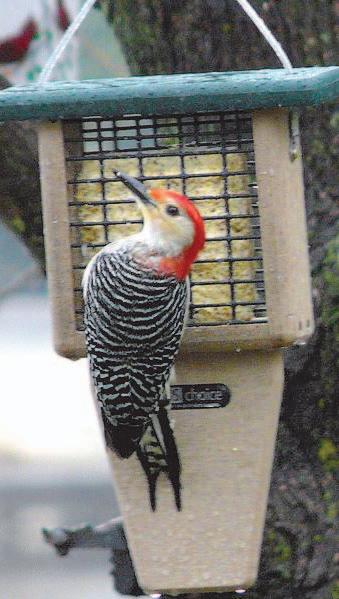

so thirsty birds do not have to use critical energy to melt ice and snow to drink.
Feeding birds in the backyard can be a wonderful winter activity, and if you offer the best, calorie-rich foods birds need, you’ll be amazed at how many birds come visit the buffet.
Terrie Schwartz Wedel’s Nursery, Florist & Garden Center
means there is some kind of trouble brewing. That seems self-explanatory to us, but apparently not to everyone.
“Keeping all the balls in the air,” which we say to mean juggling multiple tasks at one time, has gotten a chuckle from her work friends as well.
These are some phrases our family uses, I’m sure your family has a few of your own.
Happy Thanksgiving to you and yours!
Jackie Merriam
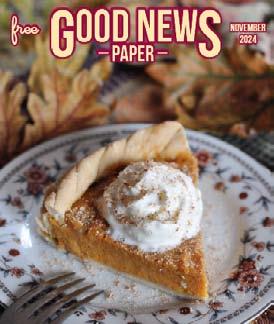
Ellis
Merriam

Worrying. What good comes of it? Nothing? Or is it an opportunity for gratitude? There’s been a lot on my mind over the past few weeks. I’m prone to worry, anxiety, fretting, and over-thinking. These are traits that are part of my character and personality, and I’ve learned to use a level of awareness so that I don’t let them overrun my life. Lately, intrusive thoughts, concerns, worry has been winning.
I attended a training courtesy of my employer on the importance of resiliency. We practiced mindful-
ness and grounding, and there was an activity that can be used to bring us back to the present called: “Help Now.” Visuals, memories, items, people, that bring us joy and can be like a shock to our system to bounce us out of the sad or the worrying and get us back into a functional state.
Throughout recent years, I’ve relied on hiking and spending time in the woods to regulate my emotional state and give me some grounding, feet moving along the literal ground. Step after step, when in the woods, I can release my worries to the trees. With every step forward, my breathing evens and my head clears. Leaf in hand, there is an opportunity to express gratitude. For every fallen leaf we pick up and hold in our hand, we take a moment of unspoken gratitude. Thank you leaf for your beauty, your shape, and your past purpose to provide me shade, protection, and help give life in the air I breathe. What is worry? We have so much, or so little, and it creates worry and concern. We love someone and then we worry about them. We need something, and we worry how we will be able to obtain it. We have something, and we’re afraid we’re going to lose it. We are healthy and worry we’ll get sick. We’re sick and worry

we won’t get better. We are worried about what’s wrong with our appearance, our social skills, our job performance, just about everything worries us.
I’m going to share a secret with you: trees don’t exist with this worry. Every fall, the deciduous trees will lose their leaves, and I doubt they worry. With every worry, I need to change my thinking and express thankfulness for the thing, the person, the situation to worry about. I am thankful I have opportunities to worry and care, to love and want, to have, and to have not. Leaves are going to fall. Let’s take time to pick them up, take a minute, and say thank you. I am thankful for a home, a car, children, a husband, an old dog, good health, and happiness. All the worries can go with the seasons because if I have many things and people to worry about, it means I have been blessed with much. 20 original art prints are included in

this month’s issue of the Good News Paper. I hope you share them and find gratitude in this act of giving.
Peace, Love, and Art. -Amy Instagram: @amylgieschen

Filled with wrapped caramels for an extra special treat
Place your order today!

Michigan’s history contains tales of conservation triumphs, and among these the remarkable resurgence of the Wild Turkey. Once prolific across the state, by the late 19th century, unregulated hunting, habitat destruction, and disease had decimated the population, leading to their disappearance from Michigan’s landscapes.
However, spurred by growing conservation awareness in the mid-20th century, Michigan’s Department of Natural Resources (DNR) embarked on an ambitious mission to bring back the wild turkey. Collaborating with wildlife experts, biologists, and local stakeholders, the DNR developed a comprehensive strategy for their reintroduction.
Beginning in the late 1950s, the first wild turkeys were sourced from areas with healthy populations in other states. The Eastern wild turkey (Meleagris gallopavo silvestris), a subspecies native to the eastern United States, including Ohio, Indiana, and Wisconsin. These regions provided suitable habitats and
thriving turkey populations, making them ideal sources for the reintroduction program. By carefully selecting birds from robust populations, conservationists aimed to ensure the genetic diversity and adaptability of the turkeys released into Michigan’s landscapes.
One significant location chosen for the reintroduction effort was the Allegan State Game Area. Selected for its diverse habitat, ample food sources (Scrub and other oaks for acorn production), and suitable terrain, Allegan was deemed an ideal site for establishing a thriving turkey population. The Allegan State Game Area, spanning over 50,000 acres in southwestern Michigan, provided a mix of woodlands, wetlands, and open fields, offering turkeys the necessary resources for survival and reproduction.
Fifty Wild Turkey from Pennsylvania were release into the Allegan State Game Area in 1954 –followed by some subsequent releases into the early 60’s. The current Wild Turkey population is estimated to be more than 200,000.
The introduction into the Allegan State Game Area was conducted in
collaboration with local wildlife officials, biologists, and conservationists. The decision to reintroduce turkeys into Allegan was not only driven by ecological factors but also by the area’s potential to support sustainable hunting and recreational opportunities for outdoor enthusiasts.
Yet, the reintroduction faced challenges. Adapting to new environments, predation pressures, and habitat fragmentation, were among the hurdles. Through careful management and continuous monitoring, conservationists persisted, adjusting strategies to enhance the turkeys’ survival prospects.
Community involvement also played a crucial role in the success of the initiative. Through educational programs, outreach initiatives, and partnerships with conservation organizations, residents became stewards of our natural heritage. Volunteer efforts in habitat restoration, population monitoring, and other public conservation efforts that sustained the ambitious program.
Over time, the fruits of conservation efforts became evident. Wild turkey populations gradually expanded, reclaiming their place in Michi-
gan’s forests and farmlands. Scientific monitoring confirms healthy population growth across the entire state. Michigan is once again home to a thriving wild turkey population throughout the state. Not long after reintroduction and successful habitat management and recovery efforts, hunting of wild turkey resumed in Michigan in 1968 offering renewed recreational opportunities.
However, the work is far from over. Continued habitat preservation, predator management, and research into turkey behavior and ecology are crucial to ensure the long-term viability of the population. As Michigan continues to cherish its natural heritage, the alluring gobble of the wild turkey resonates once more through our wood and fields, a testament to the resilience of both the species and our out-of-doors heritage.
What began with the uncertain, but hopeful, release of a few birds within the Allegan State Game Area, now stands as a gratifying demonstration of successful conservation efforts and Michigan’s enduring bond between man and nature.
James D. Coppinger


When you choose Bronson for cancer care, you get the skill, compassion and fierce determination of a whole team of experts. Our specialists are leaders in cancer care and our centers in Battle Creek and Kalamazoo are rated among the best in the nation. We work closely with you and your family to develop a personalized care plan that guides and supports you throughout medical, surgical or radiation treatment and recovery. Together, we bring national level expertise to you so you never have to go far for care!


For book recommendations from your Kalamazoo Public Library Staff go to www.kpl.gov/blog/

Stephanie Booth (Sourcebooks Landmark)
Libby is one of the most famous and sought-after children s authors, but her identity is also a complete secret. She is under pressure to write the final book in her series, but something is wrong and she just can't get it done. In her search for answers, she starts a quest that will bring her to a very different place in life
—Linda Quinn, Library Reads Ambassador, CT
NoveList read-alike: The Wishing Game by Meg Schafer

T The Seque he Sequel: A No l: Novveel l Jean Hanff Korelitz (Celadon Books)
This fiendishly blackhearted takedown of the literary world is a follow-up to Korelitz's bestseller The Plot, a novel about a washed up writer who finds success after he steals the storyline from a deceased student. This time we follow the story of Anna, the widow of the aforementioned writer, who surprisingly now has a runaway bestseller of her own.
—Alisa Stanfield, LibraryReads Ambassador, IL
NoveList read-alike: I'm Not Done With You Yet by Jesse Q. Sutanto
T The W he Wedding Witch edding Witch Erin Sterling (Avon)
This entertaining, romantic romp has it all: flirty banter, an unusual premise, and even time travel! Tamsyn and Bowen are drawn to each other, especially when a curse sends them 50 years into the past. The characters are interesting and fleshed-out in their own right, and when they get together, it’s magical.


Two sisters attend Princeton ten years apart. Days before the younger sister's graduation, she's found dead. Maya can't believe Naomi's death was an accident, and looks toward Greystone, a secret society to which both sisters belonged, and a charismatic professor. Told in dual timelines, there are twists and turns that readers won't see coming. This novel is a welcome addition to academic thrillers


A Song to Dr Droown Riv wn Rivers ers Ann Liang (St.
Fanli, advisor to a defeated king, plots to bring down the victors. To do so, he embarks on a search for a beauty to present to the new king, who can also act as his spy. Xishi is more than a pretty face: she is adept and cunning, and has her own reasons to want vengeance. A fascinating story covering themes of revenge, sacrifice, and the political realities of war



WI
read-alike: This Spells Disaster by Tori Anne Martin
Bl Blood Ov ood Over Bright Hav er Haven en M. L. Wang (Del Rey)
Sciona's brains and ruthlessness enable her to become the firstever female highmage in highly civilized and magical Tiran. Rampant sexism means the only lab assistant she can get is Thomil, a janitor refugee. The partnership is surprisingly effective until they make a breakthrough that threatens to destroy Tiran. A gripping and intense fantasy that will appeal to readers of dark academia.


A lonely noble's daughter enters into marriage with a minotaur so that she can join a treasure hunting guild to restore her family’s wealth and protect her people. Her new husband, Hawk, who happens to be a member of the guild, has no idea that his wife is a noble in disguise This steamy paranormal fantasy romance is filled with found family and sweet characters
T The L he Last One at the W ast One Wedding edding Jason Rekulak (Flatiron Books)
Maggie is getting married, and her dad is thrilled to be invited, even though they have been estranged for three years. Why the estrangement? The answer to that question and other crazy rumors about the family hosting the event fuel this engaging, suspenseful read. This will appeal to readers who enjoy hard-toguess plot twists
a
er
Cordelia's hobby of killing sexual predators and getting away with it exhibits her precise planning and execution skills. But things begin to unravel when her friend starts dating someone Cordelia suspects is bad. Crazy things, such as a body in a bathtub, a kidnapped dog, and a smiling cop. combine to add dark humor, making this a thoroughly enjoyable read.









“Welcome home!” I called out as the car pulled into my drive and a tall, slender man I had never seen before emerged. Mort and I had exchanged a few emails but never met—until now. This was a homecoming for him. While not the original builder, Mort had lived at Z Acres—my little red farmhouse on a 10-acre plot in Allegan County— from 1973 to 2008. I moved here in 2012.
I couldn’t wait to hear his stories, to learn the history of this property. Title deeds I had found here upon moving in put its history back to 1832. I would soon learn from Mort, as we strolled side by side around the perimeter of the back field, that my little red farmhouse dated back to the 1920s. More than a century was embedded in its walls. Mort, however, may as well have been its builder.
“It had been abandoned for years when I found it,” he said. “A family of raccoons lived in the house, and it was a ruin. I bought it for $6,000.”
He rolled up his sleeves and went to work. Mort added the bedroom that is now the master upstairs. He moved the wood stove to the right, further into the living room to make space for a wider staircase. He added a bathroom—oh, thank you!—to replace the outhouse to the north of the house. He fixed up the kitchen


and brought in the vintage stove, originating in the 1800s, that I still use today. It works on propane on one side and burns wood on the other. He added a greenhouse, built a tool shed I now use for my chickens, built a quirky, two-story cottage on the wooded hill in which no two windows match. Best of all, he built a large barn with a barn door on either end. He built boats in that space.
As we walked the property, he stopped to look up admiringly at the row of soaring white pines. “Those trees are 50 years old,” he said. He had planted each one, a row of tiny saplings. Indeed, he had planted most all the trees on the property, ensuring a green and lush privacy far into the future. The house that once sat in the



middle of an empty field was now surrounded by trees—pines, walnuts, ash, elms, and the tallest birch I had ever seen.
Mort even created the pond in my front yard, and he told me the story of the little girl who visited and released her two tiny goldfish in the pond. It is now filled with large koi, swimming in schools between the lily pads.
We sat down at the kitchen table, and Mort brought out an envelope of black and white photos from his first days here. I stared at each one, doing my best to travel back in time and learn about this property that I love so much. Mort shared that he had avoided ever coming back for a look in the years since he had moved away,
be
cause he feared future
owners might not cherish the property as he had. He knew now that it had passed into loving hands and a devoted heart. In all my many moves over my lifetime, I had never put down roots until I moved here.
Mort tapped a foot against the worn hardwood floors in the kitchen. He put those planks in. He ran his fingers along the edges of the kitchen counters. Those, too, were his.
“It really hasn’t changed much,” he said.
“And it won’t,” I said.
Whenever I had moved to a new place before, I had made the house an extension of myself, my style. I didn’t do that here. When you move into a home with a century in its bones, you become an extension of the home and not the other way around.
Zinta Aistars


Maybe it is the turkey feather I found in the grass or a recent hike with our GPS (German Shorthaired Pointer) that led me to counting the blessings of life with a shorthair. All three of our GSPs arrived into our lives either the month of thanksgiving (November) or in December.
Hans was our “first born.” An eighty-pound male who wasn’t “worth” anything in pedigreed society because of the white marking on his ear was more valuable than gold to us. He was a natural born raise his paw kind of fella, evident almost immediately when I kneeled on the floor and became his first object to stealthy point.
We sometimes regretted we introduced Hans to tennis balls. Our arms can affirm we got more of a workout than the automated machines at a tennis court. Hans would stay in

position until we gave the release command that he could go and find the yellow object somewhere in the woods where we had tossed it. Two minutes or ten, never was a tennis ball left unfound.
His favorite place was anywhere we were going, and Hans taught us that we only needed one speed when parents of a shorthair. Go.
Roo came along when her big brother was ten or eleven years old. We didn’t know when we brought home a little girl not yet named, watched her very quickly jump hop across our living room floor quicker than a lightning bolt, and simultaneously said to each other “Roo” (short for Kangaroo) that we were about to learn from our second shorty what it meant to believe your corner of the world could be as big as you wanted it to be.



Just ask the turkey she brought home to us when she was six months old from some unknown location in the woods.
Roo didn’t care for tennis balls. She also found staying in one place waiting for any kind of release command for any length of time just a tad too hard to do. But exercising with the squirrels and as my running partner ranked right up there as her favorite things.
Kutana completed our family unit in December 2019, debatable to her sister Ginger the first few months that we weren’t already complete before a puppy. A quiet, observant little girl sitting in a greeting pen, ignoring a little fella from another litter eagerly jumping and clamoring for attention. When I bent down and extended my hand, Kutana gently placed her chin in my palm. My heart
became hers and she came home.
Kutana wrote the book on pointing. Front paw or back paw in point, she isn’t choosy. Her sneak is poetry in motion. Her nose is also her incredible gift and sometimes our curse. Her ability to smell plus her love of food keeps us aware of dishes at counter edges.
Kutana is certainly about go; after all, she is a shorthair. What she also teaches us is wherever go is, do so with pure joy in your heart.
May blessings overflow to you and yours this soon to be thanksgiving season. May you experience it all with pure joy!
Christine Hassing https://christinehassing.com





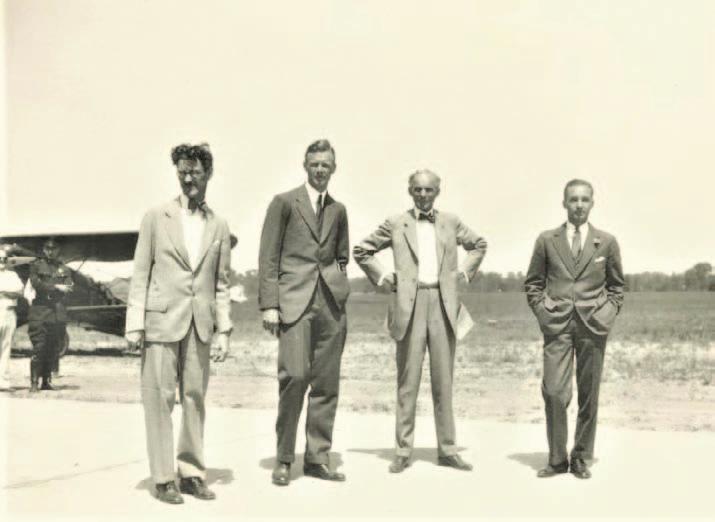
One hundred years ago, in November 1924, “the first modern airport in the U.S.” was dedicated in Dearborn, Michigan. Ford Airport, one of the many creations of Henry Ford, pioneered many features that have become commonplace among the world’s airports.
Henry Ford’s cultural impact on the world remains to this day. Called “the father of modern assembly line production,” his innovations put millions of people on the roads and into the skies, and his introduction of higher wages for workers was a significant factor in building America’s middle class. Fortune magazine named Henry Ford “the Businessman of the 20th Century.” One of his keen interests, acquired largely from his son Edsel, was aviation. The Smithsonian Institution says “One of the greatest events of the 1920s was Henry Ford’s entry into aviation” and that Ford Airport led to many American cities building their own airports.
Many people today are aware of Ford’s B-24 Liberator bomber plant at Willow Run and the Ford Tri-Motor airplane. But Ford Airport in Dearborn, globally acclaimed and ground-breaking in its day, is less well known. In the “circle of life” of business, Ford Airport, which opened in 1924, lasted only 23 years, ceas-
ing operations in 1947. Today, Ford Motor Company’s Dearborn Development Center marks the airport’s former location, just east of the Henry Ford Museum and north of the Dearborn Inn, which opened in 1931, one of the first hotels in the world built to serve an airport.
Ford Airport was the first airport in the world with concrete runways, which alleviated takeoffs and landings on muddy fields. It was also the world’s first airport with a radio guidance beacon, a technology developed by Ford’s engineers and first tested in 1926. The 500-watt beacon allowed pilots to fly in dark and cloudy conditions, and utilized the same general principles used with today’s aviation guidance systems. The airport also had the world’s first airport passenger terminal.
In addition to those world firsts, Ford Airport was the nation’s first with air-mail service, airport limousine service, and regularlyscheduled continuous passenger airline service. It was also home to the factory that built the Ford TriMotor, the revolutionary all-metal aircraft that carried passengers, cargo, and air mail. The factory and passenger terminal were designed by industrial architect Albert Kahn.
From 1925-31, Ford hosted annual “Reliability Tours” that


visited up to 13 Midwestern cities. Dozens of aircraft participated. Every year, the owner of the safest airplane was awarded the Reliability Tour Trophy.
The airport’s most unusual feature was probably its 210-foothigh airship mooring mast, the only privately-owned mast in the world. It was designed to dock the 650-to-800-foot-long behemoths of the skies such as the Shenendoah, the Akron, Graf Zeppelin, and the Hindenburg. However, the mast was only used twice. By the 1940s, larger and faster aircraft made Ford Airport—in its suburban environs—obsolete. The airport’s last notable event took place in 1934, when Jeannette Piccard and her husband, Dr. Jean Piccard, performed a ballon ascension, reaching 57,979 feet, making Jeannette the first woman to enter the stratosphere. After five hours, the Piccards landed 225 miles to the southeast, in Cadiz, Ohio.
In 1946, a demolition crew attached cables to the mooring mast and toppled it, with Henry and wife Clara looking on from the back seat of their limousine. Henry died six months later. Then, six months after Henry’s death, his company issued a press release that Ford Airport was closing. Like the Model T and the Tri-Motor, Ford Airport served an important purpose and then passed into history.
Tony Ettwein HistoryZoo1837@gmail.com
All images from the Collections of The Henry Ford
A. William B. Stout, Charles Lindbergh, Henry Ford, and Edsel Ford at Ford Airport, 1927 B. Stout Airplane Circles the Dirigible Mooring Mast at Ford Airport, 1925 C. Ford Tri-Motor Airplane in Flight over Dearborn Inn, 1931





We, as a society, need to do better in taking care of our mental health. The stigma surrounding mental health is decreasing, and more people are reaching out for help if they are struggling. However, there is still work to be done to break the barriers related to mental health.
When you are sick with pneumonia, cancer, heart disease, or other health issues, the first thing you do is contact a doctor. The doctor provides you with a treatment plan for healing, and you follow their instructions for care. You should have the same mindset with your mental health, and many people do. You can contact a therapist and set up an appointment where together you can create a treatment plan to assist in increasing your mood, energy, and zest for life while decreasing your anxiety. Your therapist will share psychoeducation to assist you in using tools outside of the therapy office to enhance your healing journey.
Some people go to therapy but don’t share that with others, which is okay, but wouldn’t it be nice to be able to say, “You know, I’m not feeling well mentally, and I am trying to take care of my mental hygiene.”


Going to therapy is a sign of strength and self-care. You are saying to yourself when you make the first step in your therapeutic process that you are worth working on. Sharing with others is okay; it may help other people take the first step in their healing process.
Some people may have had a bad experience with therapy in the past, but that doesn’t mean you shouldn’t try it again. There are many therapists out there who are willing to help and support you on your journey. If one therapist wasn’t the right fit for you or you didn’t feel a connection, it is okay to shop around for one who may be the right fit. I tell my clients all the time that if they don’t feel I am a good fit, it’s okay, and I am happy to provide referrals if needed. Remember, there is only one you, and you only have one life to live. Just as you take care of your physical health, take care of your mental health. Here are some things you can do to create mental health hygiene.
• Get adequate sleep.
• Spend less time on social media.
• Find things you enjoy doing.
• Create an activity list for mood.
• Exercise
• Eat healthy foods.
• Do things with other people and alone.
• Meditate
• Practice Self Care.
• Limit or Eliminate time with toxic people.
• Recognize your strengths
• Use mindfulness.
• Practice tools your therapist has provided you If you struggle with sleeping, it could be the reason why you have less energy. Try finding a nighttime routine to help you de-stress before bed. Spending less time on social media could boost your self-esteem, as you won’t constantly compare yourself to others or wish your life was as exciting as theirs appears to be online. Finding activities you enjoy can bring you joy, lead to more good days, and improve your overall mood. If you struggle to find enjoyable activities, creating a mood-boosting activity list can help by providing a visual of what has previously improved your mood, what you need more of, and what you want to try. Having a workout buddy can also motivate you, as exercise triggers the release of endorphins, the feel-good chemicals. Eating healthy
foods provides more energy and can potentially aid in weight loss, which can improve your overall mood. It’s important to have people in your life with whom you can share common interests or vent. If you feel lonely and lack friends, consider joining meetups in your area to meet new people. Spending time alone allows for self-reflection, helping you set goals or plan your next steps. Meditation or mindfulness can help calm your mind, through deep breathing and stress relief. Limiting time with toxic people creates space for more positive influences and reduces stress. Therapy provides a wide range of tools that, if used outside of the session, can help you recognize your strengths and maintain a healthy sense of self-regulation.
If you are struggling and are ready to gain control over your mental health, consider checking out Psychology Today, where therapists are waiting to assist you on your healing journey.
Author: Dr. Julie Sorenson, DMFT, MA, LPC




Trauma affects many people; it is important not to allow yourself to say, “My trauma isn’t as bad as someone else’s” We must learn not to compare traumas or think yours isn’t as bad as someone else’s trauma, so you don’t need help. Allowing yourself to process through your trauma could decrease your anxiety, increase your mood, and decrease the reels you may be playing in your mind. Trauma can cause people to have triggers they may not even recognize they have. They could react to things differently than they normally would when a trigger surfaces.
The definition of trauma is a person’s emotional response to events that are distressing, scary, dangerous, or shocking. Some of these events may put people in harm or death causing an overwhelming feeling. People who experience trauma can affect their mental health, physical health, and social skills.
Behavior problems can be linked to people who have suffered traumatic experiences. Sometimes people will engage in risky behaviors and possible substance abuse if they have experienced a traumatic event or events. Mental health conditions can be found in some people who have experienced trauma.
There are many types of modalities that therapists use to treat trauma but one I have seen work well is EMDR (Eye Movement Desensitization and Reprocessing Therapy. EMDR was created by Francine Shapiro in 1987. EMDR assists in helping heal from past trauma, anxiety, or difficult life experiences. During the process, you may experience deep emotions such as grief, anger anxiety, and fear. EMDR can treat people who have experienced PTSD (Post Traumatic Stress Disorder) but has been known to treat the following:
• Panic Attacks
• Grief
• Personality Disorder
• Phobias
• Dissociative Disorder
• Disturbing memories or thoughts
• Eating Disorders
• Pain
• Performance Anxiety
• Stress reduction
• Physical or Sexual Abuse
• Addictions
• Body Dysmorphic Disorders
When someone is very disturbed it is difficult for the brain to process information. It is almost as though a moment becomes “frozen in time.”
People have expressed remembering the trauma may feel as it did when they experienced the trauma the first time they encountered it. These images affect the way someone may view the world or interact with others. EMDR allows the brain to process information that may have been blocked. In an EMDR session feel-
ings, images, and sounds are brought to the service allowing for processing but not forgetting an event. EMDR assists people in recalling events with a less disturbing view of the event after they have been able to process it. As a therapist trained in EMDR, I have seen firsthand how this modality helps people to clear their brain pathways experiencing less anxiety and a better overall mood. I highly recommend anyone experiencing trauma reach out to a trained EMDR therapist to start your healing journey.
Dr. Julie Sorenson, DMFT, MA, LPC
Resources
EMDRIA, 2005, What is the EMDR International Association, Adult EMDR Brochure, PDF Shapiro, F, 2018, Eye Movement Desensitization and Reprocessing (EMDR) Therapy, The Guilford Press










I thought I had learned everything there was to know about yams when I was a kid, while standing patiently in the produce section of our local grocery with Mom. She was very particular about them and took lots of time selecting them.
I appreciate now that she took the time to explain herself by stating as she poked through the pile, “Select only the long, skinny, burnt orangeskinned potatoes because they are superior to the fat, rotund, lightskinned ones.”
I never asked her, “Why?” until the day I was talking about yams to someone and they sternly corrected me by stating, “There are no such things as yams in America!” “What?” I thought to myself. “Mom wouldn’t steer me wrong, especially


over her favorite vegetable.”
Feeling confused, I decided to look them up (which was in an actual book back then) and learned that this whole yam vs. sweet potato squabble started back in the early 1900s, thanks to a Louisiana sweet potato grower. He wanted to distinguish his moist, darker orange-fleshed sweet potato from the more common, lighter-fleshed, dry tuber commonly available. Calling his auburn-hued variety a Louisiana Yam, which was exactly the variety that Mom picked out from the produce bin. That said, true yams are very starchy, not very sweet, and can grow as large as 100 pounds, so while the person who corrected me was also not technically wrong, Mom (God bless and give rest to her soul), was not wrong about the type of sweet potato she preferred, as well!
Today, there are about 6,500 sweet
potato varieties, and they come in various skin colors, offering us creamy white, yellow-orange, tan, reddish-purple and red skins, and flesh that ranges from orange, yelloworange, white, purple, and red as well. However, most of the sweet potatoes produced in the United States are either the darker, moister fleshed Beauregard (Louisiana Yam) or the light orange, rotund Jewell varieties. Known as Batatas (Latin), a 4 –ounce, 1/2 cup serving of sweet potatoes provides us with an impressive 2 grams protein, 4 grams fiber, 25 milligrams of vitamin C, 28milligrams of calcium, 23 milligrams of folic acid, 20 milligrams of magnesium, 348 milligrams of potassium, and a whopping 21, 822 I.U. of Vitamin A! What’s interesting is that the dark orange variety that Mom preferred also offers more beta carotene than the lighter varieties do.
Offering us delicious flavor wrapped in nutrition, sweet potatoes offer health benefits, too. Preliminary studies on animals show that sweet potatoes can help stabilize blood sugar levels and help to lower insulin resistance, giving us more reason to add them to our holiday menu. Since there are so many dishes served during the holidays, I thought it would be fun to consider this tuber for smaller bites, too. Here now is a smattering of palatepleasing ways to add the awesomeness of a sweet potato to the upcoming holidays. Enjoy, and Happy Thanksgiving!
Laura Kurella is an award-winning home cook who loves to share recipes from her Michigan kitchen. She welcomes your comments at laurakurella@ yahoo.com.
Prep time: 15 minutes; Cook time:1 hour, 30 minutes; Additional time:1 hour, 15 minutes; Total time:3 hours.
Yield: 8 servings (one 9-inch pie)
1 large sweet potato
4 tablespoons butter, melted
2 eggs, beaten
4 fluid ounces evaporated milk
1/4 cup white sugar, or sub
1 teaspoon all-purpose flour, or sub




1/2 teaspoon pure vanilla extract
1/4 teaspoon ground nutmeg
1/4 teaspoon baking powder
1/4 teaspoon lemon juice
1 pie shell, thawed
Pierce sweet potato with a fork then microwave, air fry or bake until tender. Allow to cool, then peel and place in the bowl of a mixer.
Preheat the oven to 425 degrees.
To a mixing bowl, add butter then blend with sweet potato until smooth. Add eggs and mix for two minutes then add milk, sugar, flour, vanilla extract, nutmeg, baking powder, and lemon juice. Mix at medium speed until well blended then pour into a pie shell.
Bake in a preheated oven for 10 minutes then lower the oven temperature to 350 degrees. Continue to bake until a toothpick inserted in the center of a pie comes out clean, about 40 minutes more. Cool pie for 15 to 30 minutes before refrigerating to cool completely, 1 to 2 hours.
Special Occasion Sweet Potatoes
Prep time: 20 minutes; Cook time:1 hour, 5 minutes; Total time: 1 hour, 25 minutes. Yield: 8 servings.
5 sweet potatoes
1/4 teaspoon unrefined sea salt

1/4 cup butter (first use)
2 eggs
1 teaspoon pure vanilla extract
1 teaspoon ground cinnamon
1/3 cup white sugar, or sub
2 tablespoons heavy cream
1/4 cup butter, softened(second use) 3 tablespoons all-purpose flour, or sub 3/4 cup packed light brown sugar, or sub 1/2 cup chopped pecans
Preheat oven to 350 degrees. Lightly grease a 9x13 inch baking dish. Pierce sweet potatoes with a fork then bake for 35 minutes or until tender. Cool slightly, peel, then mash. In a large bowl, mix the mashed sweet potatoes with salt, (first use) 1/4 cup butter, eggs, vanilla, cinnamon, sugar, and heavy cream. Transfer to the prepared baking dish. In a medium bowl, combine second use 1/4 cup butter, flour, brown sugar, and chopped pecans. Mix with a pastry blender, or fingers, until it becomes a coarse meal. Sprinkle over sweet potato mixture. Bake for 30 minutes in the preheated oven, or until the topping is crisp and lightly browned.

Prep time: 15 minutes; Cook time: 30 minutes; Total time:45 minutes; Yield: about 12 servings.
1 medium sweet potato favorite oil/fat
Neufchatel or cream cheese (cow, goat, or vegan)
1 pear or apple, rinsed pecans, walnuts (or favorite nut)
Garnish (optional): A handful of fresh thyme
Preheat oven to 400 degrees. Line a baking tray with parchment paper and set aside. Wash and dry sweet potato then slice into 1/4- to 1/2-inch-thick slices. Place slices on a prepared sheet and sprinkle with oil. Toss slices to coat with oil, then spread out in a single layer. Bake for 15 minutes, take the tray from the oven and flip slices over. Return to the oven for another 15 minutes, or until the sweet potatoes lightly brown on the outer edge.
While potato slices cool slightly, slice pear or apple. Assemble by adding a dab of cheese to the top of each sweet
potato slice then top it with a slice of fruit, then a nut. Garnish with fresh thyme (if using), then serve immediately.
Meaty Sweet Potato Bites
Prep time: 15 minutes; Cook time: 30 minutes; Total time:45 minutes; Yield: about 40 servings.
4 slices thick-cut bacon
2 sweet potatoes, scrubbed clean, peels on
2 tablespoons extra-virgin olive oil
1 1/4 teaspoons unrefined mineral salt, divided use
1 teaspoon black pepper
2 medium avocados, peeled, pitted, and diced
1 tablespoon fresh lime juice
1/2 teaspoon smoked paprika
3 tablespoons chopped cilantro
Preheat the oven to 400 degrees. Place bacon on a parchment-lined, rimmed baking sheet and bake bacon until crisp. Remove from the oven and let cool.
Line two more rimmed baking sheets with parchment then using a man-

dolin or very sharp knife, slice sweet potatoes into 1/4- to 1/2-inch-thick slices, one on top of each lined pan. Drizzle both piles of slices with oil then toss to coat. Arrange slices in a single layer on sheets, then sprinkle with salt and black pepper. Bake for 20 to 25 minutes, until golden brown underneath, rotating the pans 180 degrees and changing their positions on the upper/lower racks halfway through. Remove pans from the oven, flip slices over, then roast for an
additional 8 to 11 minutes, or until golden on top. Meanwhile, chop the cooled bacon and set aside. Then in a small bowl, combine avocado, lime juice, and smoked paprika. Mash lightly with a fork, leaving the mixture slightly chunky. Set aside. Transfer baked sweet potato slices to a serving plate. Top each with a dollop of the avocado mixture, chopped bacon, and cilantro. Serve warm or at room temperature.


Prep time: 10 minutes; Cook time: 20 minutes; Total time: 30minutes; Yield: about 24 servings.
2 medium sweet potatoes, cut into 1/4 in slices
1 teaspoon unrefined mineral salt
1 teaspoon sweet paprika
3 tablespoons olive oil
5 ounces goat cheese
1/2 cup sugared almonds or walnuts
1/3 cup dried cranberries
3 tablespoons honey
2 tablespoons balsamic reduction (recipe follows)
Preheat the oven to 425 degrees. In a large bowl place cut sweet potatoes. Sprinkle them with salt, paprika and oil then toss well, making sure all is coated. Line a large baking sheet with parchment paper then spread potatoes out in a single layer. Bake for 10 minutes on each side, flipping halfway through, for a total of 20 minutes baking time. Transfer to a serving plate then top each potato with some goat cheese, walnuts, and
Prep time: 10 minutes; Cook time: 40 minutes; Total time: 50 minutes. Yield: 12 servings 1/2-gallon clean water
1 teaspoon unrefined (colored) sea salt
4 medium size (or 3 large) sweet potatoes oil for spraying
4 tablespoons melted butter
4 cloves garlic, pressed
1 tablespoon fresh chopped parsley
1 teaspoon unrefined (colored) sea salt, or to taste
1 teaspoon black pepper, or to taste
4 tablespoons parmesan cheese
Fill a 1-gallon pot with water, add salt, then place over high heat (covered) to bring to a boil. Meanwhile, wash and rinse potatoes, then trim off their ends. Quarter each potato then, once water begins boiling, place in boiling water. Cook, covered, for 20 -25 minutes, or until they become just fork-tender.
cranberries. Spoon a little honey over each bite then finish with a drizzle of balsamic glaze.
Balsamic Reduction
Prep time: 2 minutes; Cook time: 15 minutes; Total time: 17minutes; Yield: 4 tablespoons 1 cup balsamic vinegar
In a small saucepan set over mediumhigh heat, heat balsamic vinegar until it begins to boil. Once balsamic is simmering, reduce heat to medium or medium-low and continue simmering, stirring occasionally, until the desired consistency (thickness) is reached, which should be at about 1/4 cup of liquid remaining, and slightly thicker than maple syrup. Remove from the heat and cool for several minutes. Transfer to an airtight container and store in a cool, dry place for use within 3 months. If you accidentally over-reduce it, making it too thick, simply whisk in a tiny amount of warm water until it thins out.
Using a slotted spoon, remove potatoes to drain well.
Preheat your oven/grill to ‘High.’ Line a baking sheet or tray with foil then spray with cooking oil. Arrange sweet potatoes on the prepared sheet, skin side down, then use a utensil to gently flatten each potato section just until flattened, but not breaking apart.
In a small cup, combine butter, garlic, and parsley, then divide this mixture over each flattened potato piece. Sprinkle with salt and pepper, to taste, then lightly spray with desired oil.
Broil/grill until potato pieces become golden and crispy, about 15 minutes. Remove from the oven/grill, sprinkle with parmesan, then return to the oven/grill and cook just until the cheese is melted. Dust with fresh parsley, if desired, and serve immediately.

Hey y’all, its FALL! With this season (and all seasons it seems) folks of all ages and backgrounds will be gathering and getting excited to support a tradition loved and enjoyed by so many – SPORTS! Whether going out to cheer your team on in person or from the comfort of your home, team gear to show off your chosen allegiances are a major must-have for sports fans across the country. In the vintage world we have seen much explosion in these sellers and shoppers as the love of sports and nostalgia have grown to a fevered pitch in our society. Why have the same massproduced gear from your team, when you could stand out and still rep the squads?! If you read our article here often you might know; like all niche avenues of vintage retail, we are here for it!
Many vintage markets / retailers feature a few different delineations of clothing and collectibles at their events and shops. We have “true vintage” meaning mainly clothing from around the 1940’s-1980, “retro vintage” that covers most clothing from the 80’s to 2000, and finally Y2k vintage that rounds our gear from the turn of the century to the early 2010’s. In-between you will find various other niches that create the

large tapestry of what most people consider “vintage” today. A strong and super popular subset of the Retro and Y2k genres fall into teamwear from all types of college and professional teams. This could be basketball, football, soccer, baseball, and more. Tshirts, jerseys, jackets, hats, sneakers, collectibles, trading cards – the list could go on and on, its all very popular and desired today across the country.
Adding to the scale of this trend

and resurgence includes a few factors, but the main one we see is the wide net sporting gears casts across vintage shoppers. You can be an older person reminiscing on a team you’ve followed for decades, a current athlete wanting to display your knowledge of the greats from your chosen game, the youth simply connecting with vintage artwork of a team past, or the literal plethora of human achievements that have driven communal desire to celebrate our successes
through athletic competition.
The great things about vintage sports gear, is that there is no shortage! We have seen a marked growth in the number of vendors offering these items at Vintage in the Zoo market events in the past few years – on top of what had already been a well-stocked supply. Don’t be fooled though, sports gear is everywhere in a secondhand sales capacity. Check out your local thrift shop, garage sale, of Facebook Marketplace feed, sports gear is there and ready for the taking! With rare, limited, or just highly sought after items going for a hefty price tag, the ability to make profit exists and the consumer base continues to grow.
Over time we have found that Vintage clothing is sort of like people and personalities in ways; it takes all looks, styles, histories, and futures. This is how we create a big, beautiful, thriving, and dynamic community. So come one, come all! Next time you want to show love to your team of choice, consider the uniqueness of vintage, and the added environmental value to saving that super-cool throwback jersey from the landfill!
Patrick Turner / Megan Zielke VintageintheZoo.com



HOURS: Tue. & Fri. 8 a.m. - 1 p.m. Wed. Noon - 6 p.m. 2nd Sat. 8 a.m. - Noon (closed in Aug. & Sept. on Sat.) 1301 Lamont Ave. | Kalamazoo
It’s commonly shortened to “TIA” and referred to as a “mini-stroke.” Those who have had one report a sudden blindness in one eye, dizziness, and slow, slurred speech. Then, the symptoms disappear as quickly as they came. Even though the recovery is a relief, this shouldn’t be regarded as an all clear.
What had just happened was likely a temporary interruption in the flow of blood to part of the brain. It’s sometimes called a “ministroke” because it produces the same symptoms as a stroke. But “mini” does not mean not important. A major study found that about 30% of people who have TIA’s have a stroke later, whether it happens days, months, or years later. Having a TIA provides an opportunity for you to take steps to prevent a stroke.
The underlying cause is often atherosclerosis, a condition marked by a buildup of cholesterol contain-


ing fatty deposits called plaques. This buildup can occur in the carotid artery or one of its branches, which supply oxygen and nutrients to the brain.
Plaques narrow the passage way through which blood flows and is a factor in developing a clot. A blood clot moving from another part of the body, most commonly from the heart, to an artery that supplies blood to the brain may also cause a TIA. This is a common scenario associated with arterial fibrillation (AFib), a heart rhythm irregularity, which can cause blood to clot in the heart if not treated with blood-thinning medication.
Age is also a factor in TIA’s, meaning they most commonly happen to people in their 70’s. You’re also at higher risk of a TIA if a stroke has happened to a member of your family or if you’re Black. Other risk factors include high blood pressure, heart
disease, diabetes, high LDL cholesterol, obstructive sleep apnea, sickle cell disease, smoking, obesity, and lack of exercise.
Modern medicine has made significant strides in lowering the rate of stroke over time. Treatment includes:
Anti-platelet drugs. These drugs help prevent new clots from forming. Examples include aspirin, Plavix, and Brilintna.
Anticoagulants: They help reduce blood clots as well, but affect clotting system proteins instead of platelet function. Examples include Warfarin, Pradaxa, Xarelto, and Eliquis.
Lifestyle management. This involves taking good care of yourself, not smoking, exercising, eating a healthy diet, and moderate to no alcohol.
The term “transient ischemic attack” was first introduced in 1956. However, some experts are advocating a name change. Why? Because







TIA’s are more serious than the medical community previously thought. New technology in imaging tests reveal that TIA’s actually do cause damage to brain tissue, although they don’t result in disability. Plus calling them “mini” has resulted in people not taking them seriously enough, thereby downplaying their severity.
Proponents of change are recommending TIA’s be called “minor ischemic stroke syndromes.” Notice the inclusion of the term “stroke.” Changing the name may cause more people to get emergency care and improve their chances of preventing a full stroke.
Please take care of yourself. MAKING your day good or making someone else’s day good makes the world a better place. Kindness is contagious. Till next time, Ken Dettloff ACE
Certified Personal and Brain Health Trainer



Which routines are most important to you? Daily exercise? Monthly coffee with friends? Each routine serves an important purpose, lifting you up and reducing stress. Do you pursue seasonal hobbies like planting flowers and a vegetable garden? Sometimes those hobbies offer an added perk, a bit of extra income. Do you build any healthy rituals into those regular routines? All these activities share a common theme. Whether we are incorporating purposeful routines, reaping the financial and unique perks found in our hobbies, or maintaining healthy rituals, we are embarking on a journey of creativity.
Creativity, in particular, offers a springboard to work through difficult times, improving your mood, easing anxiety or depression, and reframing your thinking. Artistic expression offers another form of communication, a unique way to express our deepest thoughts. Our imaginations also provide a built-in renewable resource. As Maya Angelou wisely stated, “You can’t use up creativity. The more you
use, the more you have.”
Sharing music remains a priority among my regular routines and hobbies. Whether volunteering with Alzheimer’s and dementia patients, performing with a local Irish and Scottish music group, or including a bit of live music with my book talks, singing offers similar benefits to a light meditation session. It’s impossible to dwell on my worries when focusing on proper breathing, rhythm, and other necessary elements of a song!
When I think of “egg money,” I’m reminded of a favorite show from my youth, Little House on the Prairie. Remember those episodes when Caroline Ingalls sold the family’s extra eggs at Oleson’s Mercantile? It wasn’t a lot of money, but that little bit of “egg money” sure came in handy. While the real Caroline Ingalls likely didn’t sell extra eggs (Most frontier families maintained their own flocks, and any extra eggs were often preserved for the long winter months.), I found inspiration in the idea of slowly building savings

through a simple hobby.
Do you have any modern, creative “egg money” ventures? Perhaps that knitting hobby extends to a small Etsy store, extra veggies from the garden are sold at a roadside stand, or you earn actual egg money from a small flock of chickens. That extra bit of savings adds up over time while providing a meaningful outlet for creativity.
According to Merriam-Webster, ritual can be defined as “A ceremonial act or action. An act or series of acts regularly repeated in a set precise manner.” Do any rituals dwell within your regular routines? Most mornings, I like to prepare a pot of loose, herbal tea. There is a calming ritual found in this process: Mixing the proper blend of tea leaves, putting the kettle on, patiently waiting for the kettle’s whistle and steeping time, and then finally reaching for that steaming cup of joy.
In the midst of another Michigan winter, what about the peaceful ritual of building and maintaining a fire? Think of all those important steps:

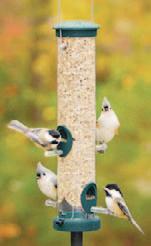


Gathering wood, building a fire, observing the dancing flames, enjoying the warmth, and later, returning to this ritual throughout the day to add a log or two. Some routines and rituals become a part of us, no planning required.
”Firewood warms you twice.” -Dr. Robin Wall Kimmerer, author of Braiding Sweetgrass
Whether we require healing, time to work through life’s many challenges, or even one of those temporary ruts, our regular routines, rituals, and hobbies are there to help. We just have to show up. Take some time this week and reflect, which routines are most meaningful to you? Keep making time for them!
Maggie Murphy is a lifelong Michigander. She is the author of the children’s book, Sara Dippity, and a contributor to Smart Women, Smart Money Magazine. Maggie also enjoys performing Irish, Scottish, and Americana folk music and running a small farm with her husband, Chad. More information can be found on her website: www. cairnhillfarms.net











The Kalamazoo Institute of Arts is proud to present Powerful Forces: Legends, Rituals and Warriors in East Asian Art. Through depictions of quiet temples and sacred deities, ceremonial vessels and devoted priests, and the esteemed figures of scholars and samurai, Powerful Forces: Legends, Rituals, and Warriors in East Asian Art illuminates the profound themes of power and legend intrinsic to East Asian heritage.
Temples, deities, priests, and holy figures are far more than artistic subjects; they are emblems central to East Asian culture and their diverse societies. These depictions, crafted with imagination, detail, and reverence, symbolize the quest for spiritual harmony and the connection between the divine and the mundane. These sacred entities invite viewers to reflect on their enduring influence and spiritual significance.
Scholars and samurai offer in-

For 71 years, the Kalamazoo Garden Council’s (KGC) sale of fresh green wreaths, roping, swags, beautiful holiday arrangements, and gifts is a two-day extravaganza not to be missed. The sale will run Fri., Dec. 6, from 10 AM to 6 PM; and Sat., Dec. 7, from 9 AM to 3 PM, at the Portage Zhang Senior Center, 203 E
sight into the intellectual and heroic dimensions of East Asian history and folklore. Scholars, often shown in tranquil settings of contemplation, represent the pursuit of knowledge, wisdom, and cultural refinement. Their depictions underscore the high esteem in which education and intellectual achievement are held. Conversely, the samurai, with their dynamic, yet disciplined stance symbolize ideals of honor, loyalty, and valor. Their portrayals evoke the complex interplay of peace and conflict, duty, and virtue.
Powerful Forces delves into the rich symbolism and mythology surrounding these divine and cultural figures, exploring the multifaceted dimensions of power and legend in East Asian art and culture. The exhibition invites viewers to contemplate the intricate relationships between spirituality, tradition, intellectual endeavors, and martial prowess that have shaped
Centre Ave, Portage, MI.
The KGC Holiday Greens Sale has become a tradition for the surrounding communities. This longstanding event will unite the talents of the nine participating Garden Clubs—bringing a vast array of holiday items for your home, gift-giving, or anyone on your holiday list. The many talented floral arrangers are evident as they create holiday table and porch arrangements, decorated wreaths, and other fresh decorations. Handcrafted boutique items and garden tools will also be on hand for that perfect gift.

East Asian societies over centuries. For More information visit the website kiarts.org. KIA is located at 314 Park St. in downtown Kalamazoo.
A. Unrecorded Artist, Head of a Temple God, n.d., wood, pigment, gold leaf. Collection of the Kalamazoo Institute of Arts; Joy Light East Asian Art Acquisition and Exhibition Fund, 2010.22
B. Kuniyoshi Utagawa, Yukukawa Sanpei Munenori from the series Deeds of the Faithful Warriors (the Story of the 47 Ronin), 1847-1848, woodblock print. Collection of the Kalamazoo Institute of Arts; Gift of Stan and Connie Rajnak, 2016.9
For decades, profits from this fundraiser have allowed the KGC to focus on charitable, environmental, and educational purposes to advance the art of gardening, landscape design, and the study of horticulture. The KGC’s mission to enhance civic beauty and aid in protecting and conserving natural resources is evident throughout our community.
For many years, the KGC Holiday Greens Sale has been a vibrant holiday event providing an opportunity for holiday décor, and an opportunity to connect with fellow gardening enthusiasts. Mark your calendar for this special event.



Step into the mysterious world of secret societies at the Kalamazoo Valley Museum’s new “Mystery and Benevolence: Masonic and Odd Fellows Folk Art” exhibit! The captivat-
ing, free traveling exhibition will be on display through Jan. 5. It opened on Sept. 28.
Eighty carvings, sculptures, textiles and regalia bring to light the his-






tories, symbolism and values of the Freemasons and Independent Order of the Odd Fellows, taking visitors behind the veil of these intriguing fraternal orders that have had an influence on contemporary American popular culture.
The seductive mystique of secret societies, with their cryptic signs and gestures, has been instilled in the American experience since the early 18th century. The exhibit seeks to answer why the two fraternal brotherhoods with deep roots in American history were created and why they endure.
Through arcane and alluring artifacts such as grave markers, serpentheaded staffs, richly embroidered textiles and ceremonial regalia, “Mystery and Benevolence” transports museum-goers to the “golden age” of American secret societies, when folk art and decorative arts were brought together to confer a sense of legacy, status and belonging in a newly es-
tablished country.
The exhibit highlights the work of the artisans who have contributed to the unique beauty of fraternal rituals for centuries. They would make and decorate such things as parade banners, aprons, symbols on a chart and backdrops for a fraternal lodge.
“Mystery and Benevolence: Masonic and Odd Fellows Folk Art” was organized by the American Folk Art Museum, New York from the Kendra and Allan Daniel Collection and is toured by International Arts & Artists, Washington, D.C.
Find out more at kalamazoomuseum.org. Admission is free to the exhibit and the museum, which is located at 230 N. Rose St. in downtown Kalamazoo. The museum is operated by Kalamazoo Valley Community College and is governed by its Board of Trustees.
Photos courtesy of the Kalamazoo Valley Museum






Just a few weeks ago, I treated myself to a trip up north. Such an expedition would have been unthinkable when I was a teacher. Those first weeks of school are prime time for students and educators alike. Escaping in still-favorable weather, and enjoying beautiful foliage and offseason rates, the trip was a treasure I will cherish and hope to repeat.
I noticed, however, the absence of deer sightings on my trip. Based on my observations just on Oakland Drive, Kalamazoo and Portage are overrun with them. How could it be that I didn’t see a single deer (or any other forest creature, for that matter) for the entire duration of my trip until I got back again to Portage?
Upon reflection, I realized that I’d answered my own question. Deer are forest creatures. Well, duh! The deer were there in abundance, just living their lives under the canopied cover of natural habitat - the beech-maple and coniferous forests that used to blanket so much of our state. The available wooded habitat in southwest lower Michigan has been disappearing for decades, and deer (and other animals) have been caught in the squeeze.
The ecological term for this phenomenon is habitat fragmentation. In greater Kalamazoo County, we have an increasingly common land management conundrum. We love living near wooded lands, including parks and natural preserves. To accommodate this love, we cut and clear space to enjoy the view from our porches and decks. I remember that one of the attractions of my neighborhood when I moved in was the abundance of mature trees. (This has proved problematic in recent years when ice storms and thunderstorms/tornadoes have become more likely, but I still love the big trees!)
Yet, in my daily drives, clearing and construction are everywhere. Growth is relentless, whether fueled by the desire for additional commercial expansion or the need for more housing. Years ago, when I was still teaching, I developed a lesson for my AP Environmental Science class that looked quantitatively at changes in county land use by using



Google Earth satellite images taken over time. The shifts in the last fifty years have been stunning, as developed property has surged and “undeveloped”/natural landscapes have increasingly dwindled.
Deer, in addition to many other forest inhabitants, thrive in transition areas between forest and land that has been cleared. In the darkness, under the canopy of trees, deer have some protection from predators (other than the automotive kind) and a safe space to bear and rear their young. Open areas, on the other hand, provide access to abundant vegetation that receives plenty of sunlight and rainfall. Living at the edge gives wildlife the best of both worlds. Geometry teaches us that as we continue to develop more land, the amount of “edge” habitat (perimeter) increases, whereas the amount of safe space (forested area) is reduced.
Our winters are also warming, and fewer deer starve, so natural population growth is occurring, as would be expected. A single doe is likely to give birth to twin fawns after her first fertile season for the duration of her life. Bucks typically “visit” eight to ten does in a season, so that activity adds up to a lot of deer that all need to eat and deserve habitat.
We, friends, are the problem. As we “dice” up natural space, either for new housing or shopping centers, parking lots, or whatever (I could go on and on…), we push deer populations into smaller and smaller spaces where they are constrained by borders that are dangerous, to us as well as the animals themselves. They eat our gardens and decorative vegetation because it’s there and available. It must seem like a tasty buffet to them, but I sympathize with the frustration of my gardening friends. Where else would we have them go?
The deer nibbling on our landscaping is not the only issue. We also have the luck(?) to live near the junction of two major highway systems, US Highway 131 and Interstate 94. Witnessing the result of deer trying to cross those roads doesn’t take much of a drive.
In 2022, a task force of city residents, staff, and environmentalists


studied the urban deer problem in the City of Kalamazoo. Their report, referenced at the end of this article, is fascinating and well worth reading. The document indicated that survey respondents disagreed on the degree to which the deer are considered a problem, with only a quarter suggesting that they are a nuisance. About half of the participants said they enjoyed having deer in their yards, although they were worried about their increasing numbers. I guess the remaining quarter didn’t have an opinion…
Local media recently reported that Kalamazoo County ranks eighth in the state in vehicle-deer crashes. A 2019 study in Wisconsin calculated that the average cost of a car-deer accident was approximately $2500$6000 but could vary considerably. Additionally, it hardly ever works out well for the deer. Since they are crepuscular, meaning they are most active at dawn and dusk, when our vision is least acute and many more cars are transporting us to work and school, it makes sense to pay special attention to the sides of the road where deer are likely to be grazing. To be honest, I am not a hunter. If you dropped me into the middle of the woods, I would surely perish. Near-sighted, fake knees – I will not be chasing down any food! I have a lot of respect for hunters, though. Their service, even to the deer population, is essential. In a time when people are hungry, they are feeding their families (and sometimes other community members) and culling the herd, curbing starvation and disease from overpopulation. The Michigan Department of Natural Resources would like to encourage more people to take up hunting, especially encouraging hunters to take more does than bucks, so that there are fewer fertile females.
I stand with the survey respondents who love the deer – watching from a distance. As a child, I remember listening to Shirley Temple tell the story of Disney’s Bambi on a 78-rpm record. (Yikes, I am old!!) But I am also a responsible adult. There are mixed ideas among residents about how to solve the deer problem in
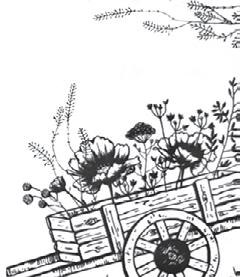
the Kalamazoo area. The city does not allow hunting, although there are circumstances where professional shooters could be employed to cull the herd. Under state law, it is illegal to remove deer from the city confines to another area, although I’d bet if the deer could vote, they’d get on the bus for a trip up north. Surgical or chemical sterilization doesn’t seem financially or practically feasible. At some time, maybe soon, we will have to develop a plan. Meanwhile, like everyone else, I’ll kick the can down the road for another few years. I will, however, slow down a little and watch the sides of the road closely!
Cheryl Hach
Retired Science Teacher
Kalamazoo Area Math and Science Center
References: City of Kalamazoo (2022, February 1). Addressing the Urban Deer Population in Kalamazoo. Community Sustainability and Our Environment. Retrieved October 4, 2024, from https://www.kalamazoocity.org/ files/assets/public/v/1/plans-amp-reports/2022.02.01_deer-mgt-report_ neigh.assn-ad-hoc-cmte._final.pdf Whitaker, A. (2024, September 10). Deer are a problem in Kalamazoo, but planned kill unlikely this year. Mlive.com. Retrieved October 4, 2024, from https://www.mlive. com/news/kalamazoo/2024/09/deerare-a-problem-in-kalamazoo-butplanned-kill-unlikely-this-year.html House, K. (2023, December 25). Five reasons why Michigan deer herds are surging: Hunting declines are just one. Bridge Michigan. Retrieved October 4, 2024, from https://www.bridgemi.com/ michigan-environment-watch/fivereasons-why-michigan-deer-herdsare-surging-hunting-declines-are McClain, J. (2019, October 17). Deer, fragmented forests, ticks, a Lyme-like disease ... And a little praise for possums. William and Mary News Archives. Retrieved October 4, 2024, from https:// www.wm.edu/news/stories/2019/ deer,-fragmented-forests,-ticks,-alyme-like-disease-and-a-little-praisefor-possums.php




Through Sunday Jan. 19, 2025
Exhibit: Kalamazoo State Hospital: 165 Years of Psychiatric Care, Kalamazoo Valley Museum
Through Sunday, Jan. 5, 2025
Exhibit: Secret Societies Illuminated In Kalamazoo, Kalamazoo Valley Museum
Fridays, Nov. 1,8,15,22,29 Family Story Time, 10:15 All ages, Richland Library
Friday, November 1
Memory Café – for people with Mild dementia and their care Partners, 10:30am – Noon Paw Paw District Library
Friday, November 1
Art Hop, downtown Kalamazoo & Vine Neighborhood, 5-8pm
Friday, November 1
KalamaTopia -Outdoor Holiday Market, dwtn. Kalamazoo, 5-8pm
Sunday, November 3
16th Annual All Stouts Day, 11am-9pm, Bells Eccentric Café
Friday, November 1
State on the Street: Battle Of the Bands, Bar-5:30pm, Music, 6pm, State Theatre, Kal.
Friday, November 1
Dia de Los Muertos, 5:30-9pm Kalamazoo County Expo Center
Fridays, Nov. 1,8,15,22,29
Quickdraw Trivia, 7-8:30pm Valhalla/Norse Nectar Meadery
Saturdays, Nov. 2,9,16,23 Kalamazoo Farmers Market 8am-1pm, 1204 Bank St.
Saturday, November 2
Harvest Craft Show, 9am-3pm Kalamazoo County Expo Center
Saturday, November 2
Kalamazoo Numismatic Club Fall Coin Show, 9am-3pm Kalamazoo County Expo Center
Saturdays, Nov. 2,9,16,23,30
Retro Cartoon Brunch, 11am-2pm, Free entry, food/drink for purchase, Presidential Brewing Company
Sundays, Nov. 3,10,17,24 Portage Farmer’s Market 9am-1pm, Portage City Hall
Mondays, Nov. 4,11,18,25
Parchment Update Interviews Parchmentlibrary.org
Mondays, Nov. 4,11,18,25
Family Storytime, 10-10:45am Books, songs. Vicksburg Library
Tuesday, November 5
The Wreck of the Edmund Fitzgerald 6-7pm, Paw Paw Library
Tuesdays, Nov. 5,12,19,26
Trivia at Sit & Stay Winery, 68pm, 260 E. Michigan Ave., Kal.
Tuesdays, Nov. 5,12,19,26
Trivia @ 468 Wine, 6:30-8:30, 8842 Portage Rd., Portage
Tuesdays, Nov. 5,12,19,26
Theme Trivia Tuesdays, 7-9pm, Revel and Roll West
Tuesdays, Nov. 5,12,19,26
Trivia Night, 7-9pm Louie’s Trophy House
Wednesday, November 6
Birds & Coffee Chat on Zoom 10-11am-Planning a birding trip birdsanctuary@kbs.msu.edu
Wednesday, November 6, 20
Mugs & Hugs, stories & more 10-11am, Vicksburg Library
Wednesdays, Nov. 6,13,20,27
Wednesday Wigglers, infant & Toddler, 10:15am, Richland Library
Wednesdays, Nov. 6,13,20,27
Dungeons & Dragons, teens, 3-5pm, Richland Library
Wednesdays, Nov. 6,13,20,27
Karaoke Bingo, 7-10pm Presidential Brewing Co.
Thursday, November 7
Adult Book Club: Conclave by Robert Harris, 9:30-10:30am Vicksburg Library
Thursday, November 7
Movie for Elementary kids, 4-6pm w/popcorn, Vicksburg Library
Thursdays, Nov. 7,14,21,28
Triple Threat Trivia, 6:30pm, must Register, Presidential Brewing Co.
Thursdays, Nov. 7,14,21,28
Live Music, 6:30- 8:30pm Saugatuck Brewing Company
Thursday, November 7
Meet MI Author: Maureen Dunphy, 7-8pm, Richland Library
Thursdays, Nov. 7,14,21,28
King Trivia, 7-9pm, Gull Lake Distilling Company
Thursdays, Nov. 7,14,21,28
Music Bingo, 7-9pm Louie’s Trophy House
Saturday, November 9
Art Detectives: Dancing Through Fields of Color: The Story of Helen Frankenthaler, 10:30-11:30am
Kalamazoo Institute of Arts
Saturday, November 9
Express Yourself! Community Day, 11am-4pm, Mak & take… Kalamazoo Institute of Arts
Saturday, November 9
Internet Users Group, Bring Your smart phones, mobile Devices & questions, 10am12pm, Paw Paw Library
Sunday, November 10
2nd Sundays Live: Kalamazoo Mandolin & Guitar Orchestra 2pm, Parchment Library
Monday, November 11
Parchment Book Group: What You Are Looking For is in the Library by Michiko Aoyama 6pm, Biggby Coffee Parchment
Tuesday, November 12
ArtBreak: Glass Art, Noon-1pm Kalamazoo Institute of Arts
Tuesday, November 12
Live Music Bingo, 6-7pm Ages 16+, Richland Library
Wednesday, November 13
BINGO Beyond Barriers, For Teens & adults with intellectual & developmental differences 1-2pm, Presented by Richland Library, 8047 Church St.
Wednesday, November 13
Genre Gathering: Spicy Romance 6:30-7:30pm, Vicksburg Library
Thursday, November 14
Teen Break & Bulldog Break, Crafts, games, social & treats 2:45-5:45, Vicksburg Library
Thursday, November 14
Writers’ Motivational Group –Support, brainstorm, discuss 4:30-5:30pm Vicksburg Library
Thursday, November 14
Studio Recital: WMU Student Composers I, 7:30pm Dalton Center Recital Hall
Saturday, November 16
Indoor Flea Market, 9-3 Kalamazoo County Expo Center
Saturday, November 16
WMU Jazz Rhythm Section Day 7:30pm, Dalton Center
Sunday, November 17
Christmas Market, 10am-3pm Girl Scouts Building, 601 W. Maple St., Kalamazoo
Monday, November 18 STEAM, 11am-Noon Vicksburg Library
Monday, November 18
Holiday Craft Workshop for Adults: Light Up Your Winter, 6pm, Parchment Library
Tuesday, November 19
ArtBreak: Curatorial Conversation on Legendary Voices, 12-1pm, Kalamazoo Institute of Arts
Tuesday, November 19
LEGO & DUPLO Club 1-2pm & 5:30-6:30pm, Vicksburg Library
Tuesday, November 19
Real World Enlightenment - ease anxiety & stress with bestselling Author Susan Kaiser Greenland, 6-7pm, Paw Paw Library
Tuesday, November 19
Mystery Book club: Murder at Half Moon Gate by Andrea Penrose, 6:30pm, Parchment Library
Tuesday, November 19
WMU Campus Choir, 7:30pm Dalton Center Recital Hall
Wednesday, November 20
Book Discussion: The Samurai’s Garden, 2-3pm, Kalamazoo Institute of Arts
Wednesday, November 20
Classic Films for Adults, 1959 Buddy comedy film, 6-8:15 Vicksburg Library
Wednesday, November 20
Open Mic Night, 8pm Louie’s Trophy House
Thursday, November 21 STEAM, 6-7pm, Vicksburg Library
Thursday, November 21
The Heartbreak Book Club: The Royal Game by Linda Keir 6:30-7:30pm, Paw Paw Library
Thursday, November 21
Slaptail Nation Presents: Slap Your Tail Comedy- Open Mic Doors open 7am, show 7:30pm Dormouse Theatre, Kalamazoo
Friday, November 22
WMU Percussion Ensemble, 7:30pm, Dalton Recital Hall
Saturday, November 23 Fine Arts Sale & Holiday Bazaar, 9am-3pm People’s Church, Kalamazoo
Saturday, November 23
Maple Hill Holiday Parade, 11am-1pm, downtown Kalamazoo
Sat., Nov. 23 – Sun., Nov. 24 Holiday Craft Show, 9am-5pm Kalamazoo County Expo Center
Saturday, November 23
Grief Circle, 10am-Noon Rootead Kalamazoo
Monday, November 25
Silent Book Club, 5:15pm Parchment Library
Monday, November 25
Jazz Combo Showcase, 7:30pm Dalton Center Recital Hall
Wednesday, November 27
Silent Book Club, 1:15pm Parchment Library